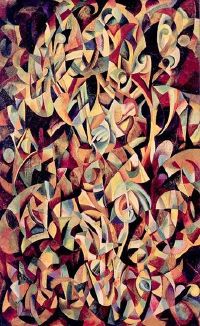Alexander Rodchenko
Aleksander Mikhailovich Rodchenko (Russian: Александр Михайлович Родченко), 5 December [O.S. 23 November] 1891 – December 3, 1956) was a Russian artist, sculptor and photographer. He was one of the founders of constructivism and Russian design; he was married to the artist Varvara Stepanova.
Rodchenko was one of the most versatile Constructivist and Productivist artists to emerge after the Russian Revolution. He worked as a painter and graphic designer before turning to photomontage and photography. His photography was socially engaged, formally innovative, and opposed to a painterly aesthetic. Concerned with the need for analytical-documentary photo series, he often shot his subjects from odd angles - usually high above or below - to shock the viewer and to postpone recognition. He wrote: "One has to take several different shots of a subject, from different points of view and in different situations, as if one examined it in the round rather than looked through the same key-hole again and again."
Life and career
Rodchenko was born in St. Petersburg to a working class family. His family moved to Kazan in 1902 and he studied at the Kazan School of Art under Nikolai Feshin and Georgii Medvedev, and at the Stroganov Institute in Moscow. He made his first abstract drawings, influenced by the Suprematism of Kazimir Malevich, in 1915. The following year, he participated in "The Store" exhibition organized by Vladimir Tatlin, who was another formative influence in his development as an artist.
Rodchenko was appointed Director of the Museum Bureau and Purchasing Fund by the Bolshevik Government in 1920. He was responsible for the reorganization of art schools and museums. He taught from 1920 to 1930 at the Higher Technical-Artistic Studios (VKhUTEIN).
In 1921 he became a member of the Productivist group, which advocated the incorporation of art into everyday life. He gave up painting in order to concentrate on graphic design for posters, books, and films. He was deeply influenced by the ideas and practice of the filmmaker Dziga Vertov, with whom he worked intensively in 1922.
Impressed by the photomontage of the German Dadaists, Rodchenko began his own experiments in the medium, first employing found images in 1923, and from 1924 on shooting his own photographs as well. His first published photomontage illustrated Mayakovsky's poem, "About This," in 1923.
From 1923 to 1928 Rodchenko collaborated closely with Mayakovsky (of whom he took several striking portraits) on the design and layout of LEF and Novy LEF, the publications of Constructivist artists. Many of his photographs appeared in or were used as covers for these journals. His images eliminated unnecessary detail, emphasized dynamic diagonal composition, and were concerned with the placement and movement of objects in space.
Throughout the 1920s Rodchenko's work was abstract often to the point of being non-figurative. In the 1930s, with the changing Party guidelines governing artistic practice, he concentrated on sports photography and images of parades and other choreographed movements.
Rodchenko joined the October circle of artists in 1928 but was expelled three years later being charged with "formalism," the Soviet slur against artists that it deemed not to be doing the work of the state. Formalism referred to art that did not have the proper "socially redeeming" content of socialist realism. He returned to painting in the late 1930s, stopped photographing in 1942, and produced abstract expressionist works in the 1940s. He continued to organize photography exhibitions for the government during these years. He died in Moscow in 1956.
Influence
Much of 20th century graphic design stems from the work of Rodchenko. His influence on modern graphic design is so pervasive that to pick out particular designers he has influenced would largely be a pointless endeavor.
His 1924 portrait of Lilya Brik has inspired a number of subsequent works, including the cover art for a number of music albums. Among them are influential Dutch punk band The Ex, which published a series of 7" vinyl albums, each with a variation on the Lilya Brik portrait theme, and the cover of the Franz Ferdinand album, You Could Have It So Much Better. The poster for One-Sixth Part of the World was the basis for the cover of "Take Me Out", also by Franz Ferdinand.
Gallery of selected works
- Pro eto by rodchenko.jpg
Cover art for About This
- 1933 Belomorkanal Work in the rhythm of orchestra by Rodchenko.jpg
1933. Belomorkanal: work in the rhythm of orchestra
- 1923 one-sixth part of the world poster by Rodchenko for film by Dziga Vertov.jpg
1923. The dark page of history gets turned over in this poster for Dziga Vertov's film One-Sixth Part of the World
- Bronenosets Rodchenko.jpg
1926. Film poster for The Battleship Potemkin by Alexander Rodchenko
See also
- Russian avant-garde
Articles in Russian
- Against Compendious Portrait for Instant Snap, first published in magazine Novyi LEF, Num.4, 1928.
- The Ways of Modern Photography, first published in magazine Novyi LEF, Num.9, 1928.
- Two articles on photo composition
External links
- Rodchenko at Masters of Photography
- The Rodchenko and Stepanova collection at The Pushkin Museum of Fine Arts
- Photo gallery at left.ru
- Rodchenko collection at The Moscow House of Photography
- Art engineers: Rodchenko and Stepanova (in Russian) – biographical article
Credits
New World Encyclopedia writers and editors rewrote and completed the Wikipedia article in accordance with New World Encyclopedia standards. This article abides by terms of the Creative Commons CC-by-sa 3.0 License (CC-by-sa), which may be used and disseminated with proper attribution. Credit is due under the terms of this license that can reference both the New World Encyclopedia contributors and the selfless volunteer contributors of the Wikimedia Foundation. To cite this article click here for a list of acceptable citing formats.The history of earlier contributions by wikipedians is accessible to researchers here:
The history of this article since it was imported to New World Encyclopedia:
Note: Some restrictions may apply to use of individual images which are separately licensed.

